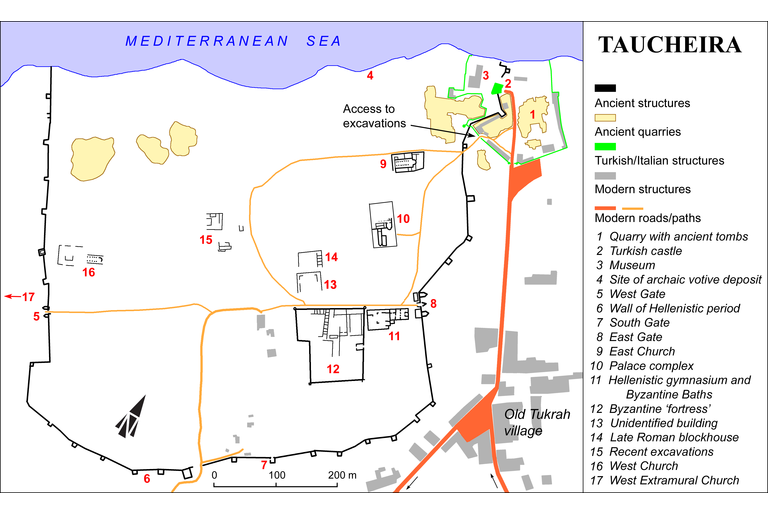Epitaph of Myrtilos
GVCyr015
Trismegistos ID: 738909
Source Description
Repository
Tocra Museum, inv. number unknown.
Support
Sandstone panel cracked in two places and broken away at the lower righthand corner (1.65; 0.45;0.08).
Layout
Inscribed on front face, in a shallow recess.
Letters
0.03-0.04; lunate epsilon, sigma and omega, alpha and lambda with right stroke projecting above, cursive mu.
Place of Origin
Date
Perhaps second or third century A.D. (lettering)
Findspot
Found in 1965 at Taucheira pleiades; HGL : reused as a paving slab, in the East corridor of the Byzantine 'fortress' , South of the decumanus.
Later recorded Location
Seen by J.M. Reynolds before 1968 at Tūkrah : Tocra Museum .
Last recorded Location
Seen in 1975 and again 1976 by Fr. Chamoux at the same place.
Present Location
Not seen by GVCyr team
Text constituted from
Transcription from previous editors.
Bibliography
Reynolds, 1996 Reynolds, J.M., 1996, Ephebic inscriptions at Tocra and Tolmeita in Cyrenaica, Libya antiqua (LibAnt)n.s. 2, 37-43 - see in bibliography , p. 40, pl. XIV, whence SEG Supplementum Epigraphicum Graecum, Leiden, then Amsterdam, 1923-1971, then 1979- - see in bibliography , 46.2222; Chamoux, 2000 Chamoux, F., 2000, Sur une épigramme de Tocra, in L. Dubois, E. Masson (eds.), Philokypros. Mélanges de philologie et d’Antiquités grecques et proches-orientales dédiés à la mémoire d’Olivier Masson, MinosSuppl. 16, Salamanca, 109-114 - see in bibliography , pp. 109-114, whence SEG Supplementum Epigraphicum Graecum, Leiden, then Amsterdam, 1923-1971, then 1979- - see in bibliography , 50.1651. Cf. Reynolds, 1998 Reynolds, J.M., 1998, The ephebic inscriptions of Teucheira, in E. Catani, S.M. Marengo (eds.), La Cirenaica in età antica: atti del Convegno internazionale di studi, Macerata, 18-20 Maggio 1995, Ichnia1, Pisa-Roma, 475-483 - see in bibliography , pp. 479-480.
Text
Μουσάων θεράποντα καὶ Ἡρακλῆος ἑταῖρον (vac. 1) | Μυρτίλον ἥδ' εὐνὴ λαϊνέη κατέχει (vac. 1)
ᾦ κανόνες τε πόδες τε διηνεκέως ἐμέλησ[αν] | πενταέθλων μελέτης γράμματι κη[δομένῳ]
Apparatus
4 Chamoux, 2000 Chamoux, F., 2000, Sur une épigramme de Tocra, in L. Dubois, E. Masson (eds.), Philokypros. Mélanges de philologie et d’Antiquités grecques et proches-orientales dédiés à la mémoire d’Olivier Masson, MinosSuppl. 16, Salamanca, 109-114 - see in bibliography γράμματι κη[δομένῳ] : Reynolds, 1996 Reynolds, J.M., 1996, Ephebic inscriptions at Tocra and Tolmeita in Cyrenaica, Libya antiqua (LibAnt)n.s. 2, 37-43 - see in bibliography γραμματικῆ[ς θ' ἅμ' ἔην] : Reynolds, 1996 Reynolds, J.M., 1996, Ephebic inscriptions at Tocra and Tolmeita in Cyrenaica, Libya antiqua (LibAnt)n.s. 2, 37-43 - see in bibliography γραμματικῆ[ς τε γὰρ ἦν]
French translation
Serviteur des Muses et compagnon d'Héraclès,
tel était Myrtilos qui repose dans cette tombe de pierre.
Il n'a pas cessé de donner tous ses soins aux règles et aux pieds
en consacrant un poème à la pratique du pentathle.
(trad. Fr. Chamoux)English translation
Servant of the Muses and companion of Heracles,
Myrtilos is constrained by this bed of stone.
The rules and feet were his constant care
and he produced a poem about the pentathlon practice.
(J.M. Reynolds' translation with some changes)Italian translation
Servitore delle Muse e compagno di Eracle,
Myrtilos questo letto di pietra trattiene.
A lui ininterrottamente stettero a cuore i metri e i piedi:
dedicò un poema alla pratica del pentathlon.
Commentary
Reynolds suspected that Myrtilos' tomb stood inside the Gymnasium, which would explain that the stone was reused in the nearby Byzantine 'fortress', more easily than if it was brought from one of the necropoles outside the city walls.
In Chamoux' view, the γράμμα was a didactical poem about the pentathlon; of course Myrtilos would also have composed his own epitaph.
Metrical analysis: two elegiac couplets.
Creative Commons Attributions-NonCommercial 4.0 International License.
All citation, reuse or distribution of this work must contain a link back to DOI: http://doi.org/10.6092/UNIBO/IGCYRGVCYR and the filename (IGCyr000000 or GVCyr000), as well as the year of consultation.
